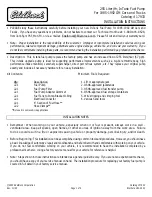
Tire and Loading Information Label
A vehicle specific Tire and Loading Information
label is attached to the vehicle’s center pillar
(B-pillar). With the driver’s door open, you will find
the label attached below the door lock post (striker).
The Tire and Loading Information label shows the
number of occupant seating positions (A), and the
maximum vehicle capacity weight (B) in kilograms
and pounds.
The Tire and Loading Information label also shows
the tire size of the original equipment tires (C) and
the recommended cold tire inflation pressures (D).
For more information on tires and inflation see Tires
on page 5-54 and Inflation - Tire Pressure on
page 5-64.
There is also important loading information on the
Certification label. It tells you the Gross Vehicle
Weight Rating (GVWR) and the Gross Axle Weight
Rating (GAWR) for the front and rear axle; see
“Certification Label” later in this section.
Steps for Determining Correct Load
Limit
1.
Locate the statement “The combined weight of
occupants and cargo should never exceed
XXX kg or XXX lbs” on your vehicle’s placard.
2.
Determine the combined weight of the driver
and passengers that will be riding in your
vehicle.
3.
Subtract the combined weight of the driver
and passengers from XXX kg or XXX lbs.
Example Label
4-25
Summary of Contents for 2009 STS
Page 13: ...Put someone on it Get it up to speed Then stop the vehicle The rider does not stop 1 9...
Page 72: ...NOTES 1 68...
Page 154: ...NOTES 2 82...
Page 157: ...NOTES 3 3...
Page 158: ...Instrument Panel Overview 3 4...
Page 340: ...4 6L V8 Engine 5 14...
Page 342: ...4 4L V8 STS V Engine 5 16...
Page 450: ...Underhood Fuse Block 5 124...
Page 462: ...NOTES 5 136...
Page 478: ...Engine Drive Belt Routing 3 6L V6 Engine 4 4L V8 Engine 6 16...
Page 479: ...4 6L V8 Engine 6 17...
















































